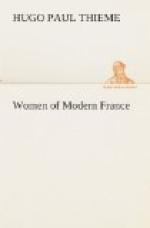Marguerite was a rare exception in a period described by M. Saint-Amand as one in which women were Christian in certain aspects of their character and pagan in others, taking an active part in every event, ruling by wit and beauty, wisdom and courage; an age of thoughtless gaiety and morbid fanaticism, and of laughter and tears, still rough and savage, yet with an undercurrent of subtle grace and exquisite politeness; an age in which the extremes of elegance and cruelty were blended, in which the most glaring scepticism and intense superstitions were everywhere evident; an age which was religious as well as debauched and whose women were both good and evil, innocent and intriguing. Everything was fluctuating; there was inconstancy even in the things most affected: pleasure, pomp, display. The natural outcome of this undefined restlessness was dissatisfaction; and when dissatisfaction brought in its train the inevitable reaction against falseness and immorality, Marguerite d’Angouleme stood at the head of the movement.
With her begins the cultural and moral development of France. It was she who encouraged that desire for a new phase of existence, which arose through contact with Italian culture. The men of learning—poets, artists, scholars—who soon gathered about the French court received immediate recognition from the king’s sister, who had studied all languages, was gay, brilliant, and aesthetic. While her mother and brother were in harmony with the age, no better, no worse than their environment, Marguerite aspired to the most elevated morals and ideals; thus, she is a type of all that is refined, sensitive, loving, noble, and generous in humanity, a woman vastly superior to her time; in fact, the modern woman, with her highest attributes.
In Marguerite d’Angouleme contemporaries admired prudence, chastity, moderation, piety, an invincible strength of soul, and her habit of “hiding her knowledge instead of displaying it.” “In an age wholly depraved, she approached the ideal woman of modern times; in spite of her virtue, she was brilliant and honored, the centre of a coterie that delighted in music, verse, ingenious dialogues and gossip, story telling, singing, rhyming. Deeply afflicted by the sad and odious spectacle of the vices, abuses, and crimes which unroll before her, she suffers through her imagination, mind and heart.” Serious and sympathetic, she was interested in every movement, feeling with those who were persecuted on account of their religious opinions.
Various are the names by which she is known: daughter of Charles of Orleans, Count of Angouleme, Duchesse d’Alencon through her first marriage, and Queen of Navarre through her second, she was called Marguerite d’Angouleme, Marguerite of Navarre, of Valois, Marguerite de France, Marguerite des Princesses, the Fourth Grace, and the Tenth Muse. A most appreciative and just account of her life is given by M. Saint-Amand, which will be followed in the main outline of this sketch.




